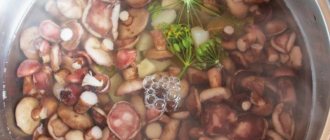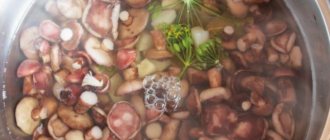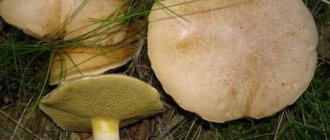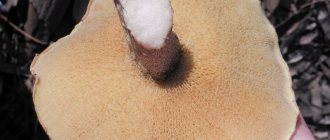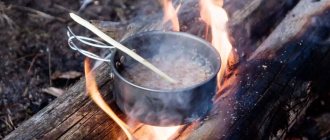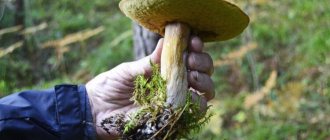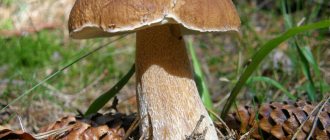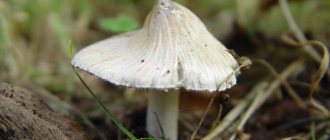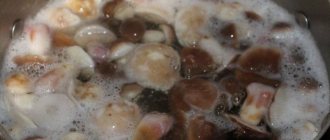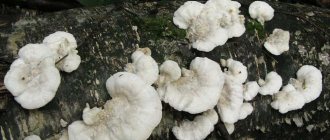Why do boletus turn pink when cooked?
There are few reasons why fruiting bodies change their color; if the butter dish turns pink during cooking, most likely the species composition of the contents of the pan, kettle or cauldron included more than just representatives of this species.
Other mushrooms are the first reason why boletus turns red or pink when cooked
Oilseeds are unique representatives of the mushroom kingdom - this is perhaps the only genus that does not have poisonous false counterparts. That is, there are many varieties whose fruiting bodies are similar to them, and these closely related species are very easy to confuse.
The substances that make up such twins are capable of changing the color of the fruiting bodies during heat treatment. And since the chemical composition of these species, as well as all representatives of the Boletaceae family, is the same, and they are all boiled in the same container, then, naturally, everything is colored, regardless of species.
Important! Mostly the color of the mushroom broth matches the color of the spores. Therefore, if a reddish or purple speck of spore suspension is visible around the fruiting body, this specimen does not belong to Maslenkov and will most likely lead to a change in the color of the broth and the bulk of the mushrooms.
Should I be concerned if the butter turns pink during cooking?
There is no reason to panic if the boletus turns pink after cooking, and besides, the taste of the dish will not even change. Almost all of their counterparts are edible and have similar physiology and, therefore, taste characteristics.
Of course, many will not like the color of pink or purple fruiting bodies in a dish, but this is not so critical, in addition, you can always use some kind of sauce or gravy to change the color scheme of the dish.
Causes of pinkness
All mushroom pickers who begin processing the harvest after harvesting should remember that boletus mushrooms will never turn red or pink during heat treatment.
If this fact manifests itself, and reddened specimens are found in the water during cooking, then these are twin mushrooms belonging to the same family as boletus - the so-called goat mushrooms. They contain a substance that can change the color of mushrooms when boiled. Even experienced mushroom pickers cannot immediately distinguish closely related boletus species, since they grow in pine forests at the same time and have the same chemical composition.
If the crop turns partially pink during cooking, do not be upset, since baby goats, like all baby goats, are harmless and do not particularly differ in taste . The only problem in this situation is the unappetizing appearance of the finished dish, however, this can also be used as an original addition.
Edible varieties
This group includes several tasty subspecies that are readily used in medicine and cooking.
Cobweb
The lamellar mushroom is popularly called violet or fat mushroom.
An autumn species, prefers to grow in deciduous and coniferous forests.
The characteristic includes several special qualities:
- head cushion-shaped or convex with a circumference of 15 cm;
- in adult and old mushrooms the cap is spread out, the edges are wavy, covered with scales, the color is dark purple with a gray tint;
- the plates are wide, sparsely spaced, purple;
- the height of the cylindrical leg is 12 cm, thickness - 2 cm, the upper part is scaly, the lower part is tuber-shaped;
- the flesh is bluish or with a pronounced nutty taste without a mushroom aroma.
Purple webwort forms mycorrhiza with several types of deciduous trees - beech, oak, birch. It can also be found next to spruce, pine, under fallen leaves, in places where mosses grow, where the soil is acidic and humus.
Peak fruiting occurs at the end of summer and ends in mid-autumn.
Purple dog
Another edible variety that belongs to macromycetes. It grows mainly in groups in places of old fires and fire pits. It begins to bear fruit in the spring and continues until mid-summer.
- the cap is of two types - disc-shaped or cup-shaped, the circumference of the apex is from 1 to 3 cm;
- the surface is smooth, lilac or reddish-violet;
- in some species a false leg may form;
- The pulp is brittle, pale purple, thin, odorless and aromaless.
Mushroom pickers rarely collect representatives of this species due to their low taste.
Ryadovka
For many mushroom pickers it is known as violet lepista or naked. Popularly called titmouse or cyanosis.
- the top is fleshy, with a circumference of 16 to 19 cm, hemispherical or convex with thin edges turned down;
- adult fruiting bodies take on a prostrate or depressed shape, the edges are curved, in some specimens the caps are wavy-curved;
- the surface is glossy, in young mushrooms it has a rich purple hue, in old ones it fades and becomes ocher;
- pulp with a mild mushroom taste and aroma reminiscent of anise;
- the plates are violet, thin, densely located;
- the legs are dense, cylindrical in shape, with a thickened base, fibrous structure. In old mushrooms, cavities appear in the thickness of the stem;
- The main difference between the mushroom is the flaky coating and pubescence at the bottom.
Purple rowers are quite large; they prefer to grow under fallen, rotting leaves. They are found both singly and in groups.
Amethyst lacquer
Lakovitsa is listed in the Red Book
This mushroom of the Rowadovaceae family belongs to the group of edibles, but is rare in our country, therefore it is listed in the Red Book. Likes to grow on moist soil in coniferous forests.
It has several distinctive features:
- cap circumference - 1-5 cm depending on age;
- in young specimens the cap is hemispherical, in old fruiting bodies it is flat;
- the main color is lilac-violet, fades with age;
- the plates are thick, the same color as the cap, later becoming white;
- cylinder leg, fibrous, purple;
- In cross section, the fruiting body is purple.
False boletus: their difference from an edible mushroom
Boletus mushrooms are suitable for frying, stewing, and canning. They have a very pleasant taste. However, when collecting boletus, you need to be extremely careful. These mushrooms, like many others, have their own “double” that is unsuitable for consumption.
False butterfly is a very poisonous mushroom and can cause severe poisoning. In addition, it is quite easy to confuse it with a real oiler. However, upon careful examination, several distinctive features of this mushroom can still be detected.
This tasty mushroom begins to grow in the forests around mid-June. The butterdish mycelium bears fruit 3-5 times during the season.
The last time mushroom pickers can pick these mushrooms is in September. Distinctive features of the oiler are:
- light brown or light yellow cap;
- tubular under-hat layer;
- yellowish-white color of the pulp (like butter).
Butterflies grow in groups of several. The space under the cap of young mushrooms of this variety is covered with a thin film. In older people, this formation is torn and forms a white ring on the stem. Some varieties of oilseed do not have such a formation.
The caps of good real butterfish are covered with a thin film, which becomes slippery when wet. This is where the name of this mushroom actually comes from.
You can distinguish real boletus from their poisonous “brother” first of all by the color of the cap. In false butterflies it has a cool, slightly purple tint.
A mushroom found in the forest, among other things, also needs to be turned over. In a false oiler, the lower surface of the cap is not tubular, but plate-shaped. In addition, this area in such mushrooms usually has a pronounced creamy-yellow color.
The rings on the stem also differ in appearance between these two varieties of mushrooms. In a regular oiler, this formation, as already mentioned, is white. Its false “brother” has a ring, like the cap, that is slightly purple and hangs down the stem.
Among other things, the ring on the stem of a poisonous mushroom very often looks dried out. In real butterfish it almost always remains alive and elastic.
You can also distinguish a false butterdish from a real one by the color of the flesh at the break. This mushroom is slightly reddish. In addition, the cut flesh of false butterflies usually darkens very quickly.
The danger of an inexperienced mushroom picker can lie in wait in the forest because of the panther fly agaric. Such mushrooms are also very similar in appearance to boletus and are also extremely poisonous. In this regard, they are even more dangerous than false boletus. And, of course, a mushroom picker must also know what a panther fly agaric looks like.
Adult panther fly agarics can be easily distinguished from boletus mushrooms by the presence of white spots on the cap. In order to distinguish a young fly agaric from an oiler, you should carefully examine its leg. This poisonous mushroom has a significant thickening at the bottom.
What a huge variety of types of flywheel mushrooms.
How can you learn to distinguish edible, tasty mushrooms from false bitter ones?
In this article we will look in detail at almost all types of these delicious mushrooms, as well as analyze the features of collection, processing and storage.
Let's talk about the benefits and harms of this type of mushroom and what delicious things can be prepared from them.
In the summer, while walking in a coniferous forest, you can find a moss mushroom. And they called it that because of the place where it most often grows - moss.
Moss mushroom is a mushroom from the genus of edible tubular mushrooms, the Boletaceae family. Previously, all species were part of the genus Boletus, but later some of them were assigned to the genera Boletus and Pseudoboletus.
The boletus is considered a relative of the boletus. Variegated, green, Polish and red moss mushrooms are the most delicious.
hat
The moss fly's cap is dry and slightly velvety. In rainy weather, the cap may become sticky and wet. With the growth and aging of the mushroom, as well as in dry weather, the cap becomes covered with scales; they appear from cracking of the cap.
The shape is semicircular and convex with smooth edges. The size can range from 4 to 20 centimeters in diameter. The pulp separates from the skin very poorly.
The color scheme of the flywheel cap is varied from light beige to dark brown, with many shades and tones.
Leg
The leg of the flywheel is usually lighter than the cap. It is varied in shape, can be curved, thicken sometimes at the bottom, sometimes in the center in some species, even at the top, closer to the cap.
The skin of the leg, depending on the type, can be smooth, ribbed, or mesh. It can reach 8 cm in length. The Volva and the ring on the leg are missing.
Pulp
The consistency of the flywheel pulp is compacted with a cotton wool-like center. When cut, the pulp has a yellowish-beige color, less often reddish. One of the important features of this mushroom is the ability of the pulp to turn blue or black when cut and when pressed with a finger.
Hymenophore
The heminophore is tubular, can be up to 2 cm in length. The mouth and pores of the tubes, both small and large, depend on the type of fungus. The color is also varied from yellow-green to yellow-brown.
The hymenium is also located here, on which spore-forming cells develop. Powdered spores are colored olive and all shades of brown.
This feature cannot be attributed to signs indicating the toxicity of the mushroom. The substances in the flywheel pulp react with oxygen, and the process of oxidation of the open surface begins when cut or broken. The resulting dark film protects the fungus from subsequent damage.
The moss fly's habitat is vast and varied. It can be found in both coniferous and deciduous forests. Naturally, it can also be found in mixed forests. Moss fly loves sandy soil among mosses, and can also grow on anthills.
Some species can be found on stumps and trunks of fallen trees. Parasitic species of moss fly grow on other myceliums, such as puffballs. Moss mushrooms form mycorrhizae with deciduous and coniferous trees.
Geography of flywheel distribution: Russia, Australia, North Africa, Asia, North America. In forests of temperate latitudes.
There are no poisonous mushrooms among moss mushrooms. True, there are controversial debates about some species. Fly mushrooms can be divided into several conditional groups: edible, false and poisonous mushrooms.
In Russia you can find only 7 varieties of flywheel, but in total there are 18 species in the genus.
For convenience, we will consider the main features of the flywheel varieties.
In central Russia, it grows in damp coniferous forests, in clearings, meadows, ravines, along the edges of wetlands overgrown with moss, reindeer moss, lichen, on blueberry and blueberry plantations, on acidic and nutritious soils near roads, as well as on sphagnum soils. swamps. The goat often lives in small groups, but sometimes in large families. It bears fruit best at the end of summer, from the beginning of August to the end of September.
The goat mushroom received the name “sieve” because it has a unique spore-bearing layer located on the inside of the cap, resembling a sieve. And the name “bolotovik” was adopted by the goat because of its preference for very moist or semi-swampy places.
In appearance, the goat is something like a cross between an oil can and a flywheel. In principle, this is a type of oil can. It differs from other boletus because its skin is almost completely inseparable from the cap.
The mushroom is edible, category four.
Cap: up to 12 cm in diameter, first convex, then flat, usually with a wavy edge, glabrous, buffy-pinkish, red-brownish or gray-pink. The skin is peeled off only along the edge of the cap.
The tubular layer is not separated from the cap, the tubes have large and uneven angular pores, slightly descending along the stem.
Leg: up to 10 cm in length, 1 – 2 cm in thickness, dense, the same color as the cap or slightly lighter than it, narrowed or even at the bottom. Often bent.
Pulp: flexible, dense, light yellowish or reddish, slightly blue when broken, without much taste, with a faint pleasant odor.
The main advantage of goat is that it contains a whole group of vitamins B1, B2 and B3, vitamins D, PP, carotene, minerals, the main place among which is phosphorus. In addition, goat also has strong antibacterial properties, so it can be used directly in the forest, in cases of disinfecting possible wounds with bleeding.
The opinions of people who visit the forest in search of mushroom luck vary greatly. Many mushroom pickers do not consider it a “mushroom” due to its rather modest taste. Others, on the contrary, recognize it as quite suitable for use and never disdain it.
Goat is eaten only after mandatory pre-treatment, by soaking or boiling, to remove excess bitterness. But, just keep in mind that when cooked it darkens and acquires a slightly purple tint. And you shouldn’t be afraid of this, this is quite normal.
And in general, all known processing methods are applicable to it. It can be boiled, fried, dried and even pickled.
The goat has no dangerous doubles; it can be mistaken for both a flywheel and an oiler (to both of which it is a close relative). So it doesn’t matter if you pick one of these mushrooms instead of goat.
Tubular mushrooms are tasty, there are few inedible species among them, but due to inexperience, you can put in the basket the extremely poisonous and dangerous panther fly agaric or unsuitable for consumption Siberian and pepper boletus.
In coniferous forests, on sandy loam, from mid-summer until the end of autumn, the dangerous agaric mushroom, panther fly agaric, grows. The cap is slightly convex, up to 12 cm in diameter, brown-yellow in color, less often brown. The skin of the fly agaric is covered with mucus and a scattering of whitish warty growths, which are located in centric circles or chaotically. The leg is hollow, smooth, with a thin ring that quickly disappears. There is a tuberous thickening at the base.
The panther fly agaric has a sharp, unpleasant odor, and under the cap there are sparse white plates, while the butterfly has a pleasant fruity aroma and spongy tissue consisting of numerous tubes. So you can easily distinguish between these species and protect yourself from poisoning.
This inedible but non-toxic species grows in cedar forests, which can be mistaken for the delicious cedar buttercup, from which it differs in lighter color. It can be used for food after carefully removing the skin and pre-boiling for at least 20 minutes.
How to cook butter without turning brown
It is recommended to boil the product before any further use:
- before frying;
- freezing;
- slicing for salads;
- for soup.
To prevent the butter from darkening during cooking, there are several tips for the housewife:
- Mushroom raw materials should be kept in boiling water for no more than 30 minutes.
- Before frying, boiling time should be reduced to 15 minutes.
- It is important to first defrost the frozen preparation, and then cook it in the same way as fresh mushrooms.
- Before freezing, the butter must be boiled a little, dried, and put into bags. It is permissible to harvest raw fruits.
- When preparing soup, the first water must be drained, and the base of the dish will be the following broth. Boiling time should not exceed 30 minutes.
- When cooking, add 1 tsp. citric acid.
- It is recommended to simmer butter in a slow cooker for about 40 minutes.
Ideas for delicious dishes: cooking boletus mushrooms correctly
Lovers of quiet hunting do not need to be told about the taste of dishes made from fresh mushrooms. But not only beginners, but also experienced cooks need to know about some of the nuances of cooking. After all, the temperature and cooking time often depend on the type of mushroom. Let's look at how to properly cook boletus mushrooms. Before cooking, they must be washed under running water and cleared of forest debris. During the initial processing of these mushrooms, the skin of the hands becomes quite dirty and darkens. To clean it, use a citric acid solution or a 9% vinegar solution.
Processing rules
At the time of preliminary preparation of the harvested boletus, it is possible to identify unwanted specimens that will color the rest of the crop. This is not very easy to do, but perhaps you just need to carefully examine the mushrooms and identify the following differences:
- if the cap is smaller in size, with a pronounced bump in the middle, it is a mushroom , which turns pink when cooked;
if there is no skirt, it’s a goat , which gives the finished dish a purple color;
if the cap is thicker than usual, it is a flywheel , it will turn red when cooked.
To get a guarantee of color constancy, even after a visual inspection, it is better to play it safe and add 2 tbsp to the cooking water. l. 6% vinegar or 0.2 g citric acid. You can use any type of vinegar - table, grape, apple, etc. If such mushrooms are used in broth or gravy, you can add tomato paste, which will make the color natural.
Edible types of purple mushrooms and their descriptions
Before you go on a “quiet” hunt for such exotic mushrooms, you need to protect yourself from mistakes
To do this, it is not enough to know their names; it is important to familiarize yourself with the photo and description of the fruits in order to understand what edible purple mushrooms look like
Purple dog
Petsitsa is a representative of the genus of the same name. The mushroom has a small fruiting body, 0.5-3 cm in diameter, cup-shaped. This species, as a rule, has no leg, since the arctic fish is a discomycete. However, a small false pedicle may be present. The surface of the arctic fish is smooth, the inner surface of the discomycete is lilac in color, but the outer surface is pale and may have a grayish tint.
The fragile and thin flesh of the mushroom does not have any taste or smell. The color of the pulp is lilac.
Amethyst varnish with purple stem and cap
Amethyst varnish belongs to the family Oryadovaceae and the genus Lakovitsa. Lakovitsa is a small mushroom with a longitudinally fibrous purple stem and a cap, the shape of which changes as it develops. In immature specimens the cap is hemispherical, and later becomes flat. The plates are located directly under the cap and slightly descend onto the stem. The rich color of the varnishes fades and turns pale over time.
The pulp is thin, has a purple color and a rather delicate taste.
Gossamer violet
The purple cobweb is a rare representative of its kingdom, belonging to the Cobweb family. The spider's cap changes shape as it grows. If at first it is convex and with drooping edges, then later it becomes flat and covered with scales. The diameter of the cap does not exceed 15 cm.
The thick leg of the cobweb, the width of which reaches 2 cm, slightly thickens downwards. There are small scales on the upper part of the leg. The length can vary from 6 to 12 cm.
The pulp has a dense texture. In mature specimens, the blue color of the flesh fades to almost white. When exposed to air after cutting, the flesh turns brown. Wide and sparse plates of the cobweb, as if shrouded in a veil. The cobweb has virtually no odor, but has a pleasant nutty taste.
Row with a purple cap and a thick stem
Ryadovka belongs to the Govorushka genus and the Ryadovaceae family. The row has other names, such as cyanosis, titmouse and blueleg.
Titmouse - a row with a rather large purple cap, 6-20 cm in diameter, is a conditionally edible species. The cap of young bluelegs has a convex hemispherical shape with the edge turned down. In mature bluefish, the cap becomes convex and outstretched. The initially bright cap acquires an ocher hue as the fruiting body grows.
The pulp of the row is fleshy and dense. Later, the flesh softens and, like the cap, acquires an ocher-cream hue. The length of the leg can reach 10 cm, and the width – 3 cm. The cyanosis leg has a dense texture and a cylindrical shape. There is a light flocculent coating on the surface of the stem directly below the cap, and purple mycelium is located at the base.
Bluefoot has a specific taste and smell, which disappears after heat treatment.
Species that turn purple when cooked
When cooked, the goat mushroom, or lattice mushroom, turns lilac in color.
The goat belongs to the genus Maslenok. The diameter of the yellowish-brown cap of the trellis varies between 3-12 cm. At first, the cushion-shaped, and later flat cap has a smooth, sticky surface. In damp weather, the cap becomes covered with mucus.
The skin on the cap fits so tightly that it cannot be removed at all or can be removed in patches. The length of the leg can reach 10 cm, and the thickness is only 2 cm. The leg, unlike the cap, is lighter and more matte, and its shape resembles a cylinder.
The pulp is quite elastic, and later becomes rubbery, and does not have a special smell or taste.
Value
Baby goat mushrooms are champions in worminess. It’s a common sight to see a huge family of dry butternut squash on the forest carpet, but there’s practically nothing to put in the basket. When harvesting fruiting bodies, a clean cut is usually visible. But this does not guarantee that the cap will be free of worms. In half of the mushrooms from the entire family it will certainly turn out to be wormy. When collecting mullein, mushroom pickers are often disappointed in them and stop collecting.
The chemical composition of goats is rich. Proteins are saturated with essential amino acids: methionine, tryptophan, arginine, histidine. But they are too poorly absorbed by the body. No more than 70% of the protein contained in dry butter is processed in the gastrointestinal tract.
The fatty substances found in these mushrooms are 95% digestible. A representative of carbohydrates is glycogen. It is easily absorbed by the body. B vitamins and carotene are concentrated in goats. They are enriched with vitamin D, phosphorus and folic acid.
How to test mushrooms for edibility when cooking and identify poisonous ones
There are several methods for determining the toxicity of mushrooms, but none of them will be 100% reliable.
You need to act carefully so as not to become a victim of poisoning. How to identify poisonous mushrooms? What methods can you use?
September 16, 2016
How to check mushrooms for edibility when cooking?
There are several precautions that need to be taken when picking mushrooms:
- deadly mushrooms belong to the lamellar type;
- among the tubular subspecies of mushrooms there are poisonous ones, but they are not fatal to humans;
- The fly agaric family is considered the most poisonous. This includes all types of fly agarics and toadstools. These varieties are distinguished by the presence of a thickening at the root of the stem and a ring near the cap;
- Honey mushrooms are not found in coniferous forests. Individuals similar to them in such forests are poisonous;
- The mushroom picker should be alerted to the strong unpleasant smell of industrial alcohol; eating such specimens can lead to unpleasant consequences;
- If the flesh of the mushroom, when broken, acquires a reddish tint, then you should not take it.
If you have the slightest doubt about the edibility of mushrooms, it is better not to eat them to avoid poisoning. There is also no need to trust the opinion that insects avoid poisonous individuals. This is not a reliable indicator of edibility.
There are several options for testing the edibility of mushrooms during the cooking process. The most popular of them are:
- During cooking, you need to put some kind of silver product in the pan. If it darkens, then the mushrooms are poisonous. This is not a reliable test. Silver can darken from substances secreted by edible species;
- There is an opinion that onions and garlic added during cooking in the presence of poisonous individuals will acquire a brown tint. The shade can also change when exposed to non-poisonous mushrooms;
- To disinfect mushrooms, boil them in a vinegar-salt solution. This may not always help. Deadly toadstools do not become less poisonous when using this method.
Testing mushrooms for toxicity using milk is also not reliable. Milk curdles not from the presence of poison, but from the action of certain enzymes. They may also be present in edible specimens. Accordingly, there is not a single guaranteed way to identify poisonous mushrooms during cooking.
To avoid poisoning and serious consequences when picking mushrooms, you need to be extremely careful. If you have the slightest doubt about their edibility, you should not eat them.
| Name: | Butter |
| Type: | Edible |
There may be several reasons why boletus turned purple after cooking. To understand what the color change means and whether something can be done, you need to understand the characteristics of these mushrooms.
Delicious boletus and their inedible counterparts
Does the oiler have inedible or poisonous counterparts? The usual types of boletus are delicious mushrooms. They have a characteristic cap. Only the yellow-brown buttercup, whose flesh turns slightly blue when cut, can disappoint gourmets due to its mediocre taste. Some Western reference books define it as inedible (but not poisonous!). Siberian oiler is also considered a non-toxic, inedible mushroom.
There are no poisonous butterflies in our forests. But it is quite possible to confuse the delicious butter dish with the pepper mushroom (Suillus piperatus). This mushroom is called: pepper butterfly. It contains bitterness, but is not poisonous. Mushroom pickers who put pepper butter in the basket say in their defense that the bitter taste is greatly reduced when cooked for 15 minutes. After this, the mushroom is fried along with other mushrooms. Pepper oil grows not only next to pine trees, but also in spruce and deciduous forests.
Swamp mushroom. Description of white boletus
The diameter of the swamp's cap is 3-8 centimeters. In youth, the shape of the caps is close to hemispherical, but over time it becomes cushion-shaped, and then completely prostrate. However, unlike the common boletus, the caps open completely very rarely. The color of the cap is whitish with various shades: light gray, cream, pinkish.
The pulp is tender, white, without any special taste or smell. The spore-bearing layer in young specimens is white, but over time it becomes grayish in color. The tube openings are angular and uneven. Olive-brown spore powder. The height of the white boletus stem varies from 7 to 10 centimeters, but if the mushrooms grow in dense grass, then their stems are higher.
The diameter of the leg is 0.8-1.5 centimeters. The stem of the cap becomes narrower. The color of the leg is white, along its entire length it is covered with white scales. The scales become dark with age or drying out. The pulp in the stem is fibrous, but in comparison with the common boletus, it is softer. At the base of the stem the flesh is bluish in color.
Distribution of swampweeds
These mushrooms are found from July to October. White boletus grows in mixed and deciduous forests. They form mycorrhizae mainly with birch trees. They prefer damp places, so they can often be found along the edges of swamps, which is why they are called swampers. White boletuses are not particularly productive, but they are not uncommon.
Features of collection
Goats cannot boast of being particularly popular among mushroom pickers, but if there are no other edible mushrooms nearby, they are also placed in a basket so as not to return from the forest empty-handed. Kids are considered real record holders for the presence of worms and parasites. It also happens that out of a whole group it is impossible to find a single clean one.
When cutting the stem of a fungus, the cut must be carefully examined. If there are no signs of worms in the leg, then pests may be present in the flesh of the cap. If there is any doubt, the mushroom cap should also be trimmed to ensure it is clean and fit for consumption. It is not advisable to take old goats home because they can easily spoil in just a few hours.
Butternuts turned pink after cooking: reasons
Butternuts are considered one of the best mushrooms, due to their excellent taste, variety of processing methods and excellent digestibility by the body. They gained popularity among mushroom pickers due to their high yield and the absence of poisonous counterparts. However, there is one point that raises doubts among beginners in the mushroom business - the redness of mushrooms during cooking. They have concerns about the quality of mushrooms and the possibility of their continued safe consumption as food. This moment does not scare professional mushroom pickers at all, because they know what the reason may be. Read more about this later in our material.
Where to look
Butterfly should always be looked for near trees, usually in the undergrowth or along the edges of paths and roads, because the fungus loves sunlight. It prefers to grow near pines and spruces or birch trees; mushrooms often grow as if in a path. There are both singles and “family” ones.
Mushrooms grow from the beginning of June to the end of September; sometimes they can still be found in October, provided the ambient temperature remains high. Their appearance is associated with rainy days; after the rain passes, the mushrooms quickly jump in size. People say that boletus grows during certain periods, which coincide, for example, with the flowering of pine or linden.
Before looking for information on how to properly cook boletus, you need to know how to clean it after returning from the forest, because they are quite dirty, but very tasty. Before work you need to prepare yourself and the kitchen:
- Cover the work surface with newspaper or oilcloth.
- Prepare two containers and a knife.
- Put gloves on your hands. Otherwise, you will have to walk around with black nails for several days.
Places of distribution and time of collection
The excellent taste and fleshy, appetizing structure, as well as the fragrant sticky juice that secretes, attract many insects, and it can be difficult to collect entire fruiting bodies of these mushrooms. Therefore, you need to notice where they grow and get up early so that at dawn you have time to pick a whole basket. Connoisseurs especially value the autumn harvest, when insect activity is minimal.
https://www.youtube.com/watch?v=JfO-PFj5ttA
Summer butterwort grows in colonies in coniferous forests, forming mycorrhiza with different types of pine. This species is found from June to October on sandy soils, in sparse plantings and clearings, in open clearings and near roads.
Larch butterflies live under slender larches of various species; it is with these trees that they form mycorrhiza and grow only where there is a root system of this species. Harvest from early summer until late autumn.
Late butterwort grows in numerous groups under pine trees on sandy loam soils. It is found under fallen needles and among the grass in deciduous-coniferous forests. Most often it grows in open areas - near roads, and clearings in clearings and forest edges.
Among the swampy pine forests, at higher elevations, yellowish swamp boletus grows; they are collected in late summer and early autumn.
In sunny forests near pines and cedars, cedar boletus grows, which most readily settle among young growth or in clearings. The first harvest coincides with the flowering of the pine, and fruiting lasts in waves until the beginning of autumn. The rare mushroom is carefully cut off, preserving the mycelium and sprinkling it with leaves.
Gray butterwort appears under pines and larches, most often forming mycorrhiza with larch. Fruiting bodies are collected from July to September-October.
Under cedars and pines, white boletus grows singly and in small groups of 3–5 specimens. The best harvests are harvested in late summer and early autumn.
Growing at home and in the country
Since cowweed is a mycorrhizal fungus and grows close to coniferous trees, therefore, it is very desirable that young pine, cedar or spruce grow on the site.
Important! Goats, like their closest relatives, cannot live without a patron tree.
Cultivation of goat kids occurs in several stages:
- Soil preparation. In the selected area (preferably in partial shade), the top soil layer is removed. Since the correct growing technology requires the formation of several layers of soil, plant materials, for example, chopped wood, grass, foliage, and pine needles are placed in the first layer. For the second layer, you need to use soil collected from the areas where the kids grow, then it will have an acid-base balance that is as close as possible to the optimal one. You can take ordinary garden soil. If necessary, humus should be added to it. Baby goat mycelium is sown on the prepared soil.
- Inoculation of mycelium. You can purchase it in specialized stores or prepare it yourself from old mushroom caps. To do this, you need to collect adult, overripe specimens and mix them with a substrate prepared from a mixture of pine sawdust and peat. The dried substrate is laid out to half a three-liter jar, compacted and filled with a nutrient solution (one and a half liters will be needed). It is not difficult to prepare: you need to take a teaspoon of sugar and the same amount of yeast for 1 liter of water. The solution is brought to a boil and peat is poured over it. Fill the remaining space inside the jar with dried sawdust and cover it with a tight lid.
- Sowing mycelium. The entire substrate is evenly distributed in a thin layer near the trees, covered with a layer of foliage or grass, and sprinkled with garden soil on top. It is very important to constantly maintain an optimal level of moisture in the soil.
- Fruiting will begin a year after planting and will continue for 15 years. In the first year, you should not count on a bountiful harvest, since the mycelium develops over 5–7 years. But in subsequent years, the harvest volume will increase significantly.
Poisonous doubles of porcini mushroom
Despite the fact that the white mushroom is considered quite common, and it is difficult to confuse it with a toadstool, it has several inedible counterparts. They are extremely rarely fatal, but can still cause symptoms of severe food poisoning.
The danger of false whites is that they grow in the same area as edible specimens, and sometimes in close proximity to them. In order not to accidentally put such a specimen in the basket, you should know the distinctive external signs of poisonous counterparts.
Outwardly it is very similar to white, but prefers to grow on well-heated clay and sandy soils. Most often it can be found on the edges and clearings of coniferous forests. Based on the place of growth, it should look like white pine, although in fact, in terms of external characteristics, it is more reminiscent of oak (Figure 2).
Among the external characteristics of bittergrass, the following should be highlighted:
- The cap is convex, brown or brown in color.
- The leg is thick, cylindrical, covered with a characteristic mesh pattern, which is absent in true whites.
- The flesh is not a pleasant cream or white hue, but slightly pinkish or off-white. The gall pulp also acquires a pink color when cut or broken.
But the main characteristic feature of this poisonous twin is that it has a pronounced bitter taste, which is why the mushroom got its name. This taste not only does not disappear, but also intensifies during heat treatment, so you won’t be able to eat it by accident. It is the bitterness that is the reason why forest animals and insects do not eat it.
Figure 2. Bitter pulp
Some mushroom pickers advise lightly licking the flesh of a suspicious specimen to make sure it is edible. We do not recommend doing this, since the toxins contained in the pulp can disrupt the functioning of the liver, and in high concentrations even cause a deadly disease - cirrhosis.
Another dangerous double of everyone’s favorite boletus. Since it belongs to the same genus, it actually resembles white in the shape of its stem and cap. The usual place of growth is considered to be deciduous forests of regions with a warm climate, and it prefers to grow under linden or hornbeam trees (Figure 3).
The characteristic features of the satanic species are the cap, which is fleshy and velvety to the touch. Depending on where it grows, it can be grayish-white, brown, or olive in color. The latter shade is more common in shady areas with dense young growth, while the light color of the cap is more characteristic of well-lit areas.
Figure 3. Sectional view of the Satanic mushroom
But the easiest way to distinguish it is by the color of the stem and tubular layer. The leg has a rich red color, and the tubular layer can be not only red, but also bright orange. If you cut such a specimen, its flesh will turn bright yellow, and after a few minutes it will acquire a bright blue tint.
How to buy mushrooms correctly
A few words about buying mushrooms at the market. If you don’t have the time or skills to pick mushrooms yourself, you can buy them at the market.
- When purchasing, you need to carefully examine the mushrooms - what condition they are in, whether there are any bruises or damage.
- Do not buy mushrooms that have been pulled out by the roots. Firstly, a person picking mushrooms thus spoils the mycelium, which means he absolutely doesn’t care what grows there after him, and, most likely, he doesn’t care what mushrooms he sells. Secondly, such an incompetent seller can slip (not on purpose, of course) poisonous mushrooms.
- Look at the cut of the leg. It should be fresh, not weathered, the edges should be smooth and not bent.
- The caps should not have any dents or darkened brown spots. If the mushrooms are limp, you should not buy them. At best, they will be tasteless.
- Do not buy mushrooms in plastic bags. This way they spoil very quickly. If they were collected directly into the bag, then they are probably no longer suitable.
We suggest you read: Why do spider mites appear on cucumbers and what to do about it?
If trouble does occur, you should immediately contact a medical facility by calling an ambulance. Before the ambulance arrives, your actions can not only alleviate the suffering of the victim, but also save his life. Act clearly and quickly:
- Don't panic.
- Perform gastric lavage and induce artificial vomiting several times.
- The victim should be placed comfortably in a horizontal position and covered with a blanket.
- Drinking regularly will help prevent dehydration and fight toxins. To do this, you need to drink milk, salted or just clean water.
- Someone should always be near the patient to ensure that the victim is conscious and give ammonia to sniff in case of loss of consciousness, otherwise a coma may occur.
What does a goat mushroom look like?
The color of the cap is reddish-brown, light yellow, yellowish-brown, red-ocher or red-brown. The skin is not separated from the cap or is removed in small pieces. The tubular layer is adherent or slightly descending; the pores under the cap are yellowish, brownish-yellow or gray-yellow, becoming brownish over time.
Interesting materials:
How to wash white leather sneakers? How to clean a large window from the outside? How to wash a kettle? How to wash a decorative rabbit? How to wash an artificial wig? How to wash Keycaps? How to wash a lg refrigerator? How to wash the inside of leather shoes? How to wash a leather sofa? How to wash laminate flooring without streaks at home?
What poisonous specimens can be found in our country?
- Death cap. Perhaps one of the most famous and most poisonous mushrooms in the world. Toadstool is dangerous because of its similarity to champignon, because even after heat treatment, a small piece of toadstool can kill an adult.
- Fly agaric and its subspecies (red, stinking). It would seem that the fly agaric, known to everyone since childhood, cannot be confused with anything, but it has many species, and some of them can easily be mistaken for edible.
- False honey fungus is sulfur-yellow. It is not difficult to guess from the name that this species masquerades as its edible fellow honey mushroom. False fungus grows almost all over the globe, and it will be extremely difficult for a non-professional to recognize it.
- Cobweb. He's very good-looking. The correct shape of the cap and a beautiful, even color can attract attention, but only an inexperienced mushroom picker will cut it off, because it has no non-poisonous counterparts.
- Red champignon. An inedible type of champignon, it can be distinguished by its unpleasant smell and reddish color of the flesh. Its use will not lead to death, but poisoning for several days is guaranteed.
- False boletus or gall mushroom. Quite often found in Russia. It is incredibly similar to its edible counterpart and it is sometimes impossible to distinguish them by appearance. But you will immediately understand that you made a mistake with your choice, because... False boletus tastes very bitter.
How to distinguish Kozlyak from oiler?
Similar species and how to distinguish them from them
| Features | Pepper mushroom | Kozlyak |
| Leg color | to match the hat or lighter | yellowish orchid |
| Taste | hot pepper | soft |
| Pulp | loose, yellow | soft, pinkish or brownish-cream |
| Flesh color when broken | slightly red in the cap | blushes slightly |
Beneficial features
Low-calorie, tasty and healthy butter with a high content of proteins, vitamins, microelements and biologically active substances will serve as an excellent addition to the diet, an element of a healthy diet.
A significant amount of folic acid is found in the tissues, which is involved in hematopoietic processes. For the formation of red blood cells, iron is necessary, of which 100 g of fruiting bodies contains up to 1.3 mg. The content of ascorbic acid, which is a valuable substance for supporting the immune system and the functioning of the hematopoietic system, is about 12 mg per 100 g of edible part.
Due to the presence of these vitamins and iron, these mushrooms can be successfully consumed in people with a tendency to anemia and weakening of the body, as a useful product and means of prevention.
The tissues of the fungus contain the most important B vitamins - thiamine, riboflavin, pyridoxine, as well as valuable minerals - sodium, calcium, fluorine.
Also, mushrooms of this boletaceae family contain significant amounts of zinc and manganese, which have a beneficial effect on the reproductive system.
Traditional medicine widely uses antibacterial properties, observing the anti-inflammatory effect of various drugs from fruiting bodies and, especially, from the slippery skin.
What mushrooms turn blue when cut and why?
Mushroom pickers are a special people. They prefer the silence and solitude of forest paths to stormy and fun fishing or hunting.
Although in terms of the ability to concentrate, concentrate and wait, these hobbies are quite equivalent, it’s not for nothing that mushroom picking is called “silent hunting”
And when it comes to patience when ignorant people ask questions about this hobby, mushroom pickers are also masters. But what are they most often asked about? It turns out that the leader among questions about “silent hunting” is the following: “If mushrooms turn blue when cut, does that mean they are poisonous?”
Looking for an answer
Let's find out the detailed answer to this question. As it turns out, blue flesh is a sign of a wide variety of mushrooms. From ordinary boletus mushrooms to the deadly satanic mushroom. And this phenomenon is not at all evidence of the presence of toxins in the pulp. Why do mushrooms turn blue in this case? This occurs due to air entering the pulp at the moment of breaking. The substances contained in its tissues oxidize and, due to reaction with oxygen, acquire a blue tint. And, as it turned out, many representatives of the mushroom kingdom are susceptible to such color changes. Even very tasty and healthy.
Yes, very different! The leader in the azure color of the flesh is considered to be a mushroom with the self-explanatory name bruise. In appearance it is completely inconspicuous, has a grayish-brown cap with a diameter of about 15 centimeters. But if you press on its surface, it will quickly turn blue. The bruise is edible in dried and pickled form, although it can be found infrequently - it is listed in the Red Book.
Another rare type of blue mushroom is the chestnut mushroom. Externally, it is very similar to the boletus in the shape and size of the cap. Therefore, if the porcini mushroom you find turns blue when cut, you are mistaken, and it is a chestnut or perhaps a Polish mushroom. There are differences between them - if the first one turns blue when pressing on the leg or when the flesh is damaged quite slightly, then the Polish one is painted with a bright blue pigment. In addition to them, two types of boletus also paint their legs with azure: the reddish boletus and the Frost boletus.
Dangerous satanic mushrooms are often confused with white mushrooms. By the way, they also fit into the category we are listing. Satanic mushrooms turn blue when cut, but only slightly. And before that, when broken, they tend to turn pink first, like many other poisonous representatives of the Berendey kingdom.
But other names of mushrooms, well known to most, belong to completely edible and very tasty species. For example, boletus and aspen boletuses turn blue when cut. Some types of oak and moss mushrooms also have azure flesh.
Conclusion
Thus, we see that a wide variety of mushrooms turn blue when cut. However, it is worth noting that of the poisonous species, only the satanic species has this ability. Therefore, if you find a fungus in the forest with a bluish tint to the cap at the break or the stem, it is highly likely that you can eat it. And in order not to confuse it with a satanic mushroom, it is worth remembering that the poisonous one most often has a domed cap, but the spores are red or orange, as is the characteristic mesh on the stem.
Panther or gray fly agaric (Amanita pantherina)
Found in the second half of summer and autumn. The cap of the mushroom is up to 12 cm in diameter; in youth it is bell-shaped, but then becomes prostrate. Its color varies from light brown to olive, the entire surface is strewn with multiple white spots. The flesh is also white with a repulsive odor.
Panther fly agaric. Photo from wikigrib.ru
The thin and hollow stalk reaches 13 cm in length. It narrows at the top and thickens at the bottom. The mushroom is similar to the harmless gray-pink fly agaric , but it is deadly poisonous. Poisoning occurs quickly: within 20 minutes to 2 hours after eating.
Characteristics, composition and description of the mushroom
The goat is a tubular mushroom of the genus Suillus (Oil Can), family Suillaceae (Oil Can), order Boletales (Boletaceae). It also has popular names: Reshetnyak, Dry butterdish, Goat mushroom, Ivanchik, Korovik, Cow mushroom, Mullein. Latin names: Suillus bovinus, Boletus bovinus.
The diameter of the cow's cap varies from 4 to 12 cm. It has a brown, reddish or brown color, sometimes with a reddish tint. At a young age it is slightly swollen, but over time it straightens and becomes even. Smooth to the touch, without cracks or bumps. The skin fits tightly to the cap and is difficult to remove.
The hymenophore (lower part of the cap) is tubular, yellowish or brownish in color, slightly lighter than the cap and stalk. The tubular layer is descending, the pores are yellowish. The spore powder is light brown and olive yellow.
Goat mushrooms have dense, elastic flesh, which becomes rubbery over time. The color of the pulp is pale yellow or light yellow. In the stem it is reddish, brownish, and when cut it turns red or pink. It does not have a pronounced odor, the taste is weak, it gives off a sour taste.
The leg reaches a height of 4-10 cm, its thickness is 1-2 cm. It has a solid cylindrical shape, often curved, tapering downward. Its surface is smooth, matte, the color matches the cap or is slightly lighter. The base is yellow.
